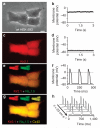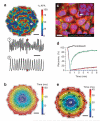Engineering biosynthetic excitable tissues from unexcitable cells for electrophysiological and cell therapy studies
- PMID: 21556054
- PMCID: PMC3388000
- DOI: 10.1038/ncomms1302
Engineering biosynthetic excitable tissues from unexcitable cells for electrophysiological and cell therapy studies
Abstract
Patch-clamp recordings in single-cell expression systems have been traditionally used to study the function of ion channels. However, this experimental setting does not enable assessment of tissue-level function such as action potential (AP) conduction. Here we introduce a biosynthetic system that permits studies of both channel activity in single cells and electrical conduction in multicellular networks. We convert unexcitable somatic cells into an autonomous source of electrically excitable and conducting cells by stably expressing only three membrane channels. The specific roles that these expressed channels have on AP shape and conduction are revealed by different pharmacological and pacing protocols. Furthermore, we demonstrate that biosynthetic excitable cells and tissues can repair large conduction defects within primary 2- and 3-dimensional cardiac cell cultures. This approach enables novel studies of ion channel function in a reproducible tissue-level setting and may stimulate the development of new cell-based therapies for excitable tissue repair.
Figures






Similar articles
-
Generation and customization of biosynthetic excitable tissues for electrophysiological studies and cell-based therapies.Nat Protoc. 2018 May;13(5):927-945. doi: 10.1038/nprot.2018.016. Epub 2018 Apr 5. Nat Protoc. 2018. PMID: 29622805 Free PMC article.
-
Genetic engineering of somatic cells to study and improve cardiac function.Europace. 2012 Nov;14 Suppl 5(Suppl 5):v40-v49. doi: 10.1093/europace/eus269. Europace. 2012. PMID: 23104914 Free PMC article.
-
Currents through ionic channels in multicellular cardiac tissue and single heart cells.Experientia. 1987 Dec 1;43(11-12):1153-62. doi: 10.1007/BF01945515. Experientia. 1987. PMID: 2446908 Review.
-
Errors in the measurement of voltage-activated ion channels in cell-attached patch-clamp recordings.Nat Commun. 2011;2:242. doi: 10.1038/ncomms1225. Nat Commun. 2011. PMID: 21407208 Free PMC article.
-
New studies of the excitatory sodium currents in heart muscle.Circ Res. 1985 Apr;56(4):475-85. doi: 10.1161/01.res.56.4.475. Circ Res. 1985. PMID: 2579746 Review.
Cited by
-
Miniaturized iPS-Cell-Derived Cardiac Muscles for Physiologically Relevant Drug Response Analyses.Sci Rep. 2016 Apr 20;6:24726. doi: 10.1038/srep24726. Sci Rep. 2016. PMID: 27095412 Free PMC article.
-
A Bright and Fast Red Fluorescent Protein Voltage Indicator That Reports Neuronal Activity in Organotypic Brain Slices.J Neurosci. 2016 Feb 24;36(8):2458-72. doi: 10.1523/JNEUROSCI.3484-15.2016. J Neurosci. 2016. PMID: 26911693 Free PMC article.
-
Microheterogeneity-induced conduction slowing and wavefront collisions govern macroscopic conduction behavior: A computational and experimental study.PLoS Comput Biol. 2018 Jul 16;14(7):e1006276. doi: 10.1371/journal.pcbi.1006276. eCollection 2018 Jul. PLoS Comput Biol. 2018. PMID: 30011279 Free PMC article.
-
Cell Systems Bioelectricity: How Different Intercellular Gap Junctions Could Regionalize a Multicellular Aggregate.Cancers (Basel). 2021 Oct 22;13(21):5300. doi: 10.3390/cancers13215300. Cancers (Basel). 2021. PMID: 34771463 Free PMC article.
-
Optogenetic Approaches to Drug Discovery in Neuroscience and Beyond.Trends Biotechnol. 2017 Jul;35(7):625-639. doi: 10.1016/j.tibtech.2017.04.002. Epub 2017 May 25. Trends Biotechnol. 2017. PMID: 28552428 Free PMC article. Review.
References
-
- Hille B. Ion Channels of Excitable Membranes. Sinauer; 2001.
-
- Catterall WA. The molecular basis of neuronal excitability. Science. 1984;223:653–661. - PubMed
-
- Kleber AG, Rudy Y. Basic mechanisms of cardiac impulse propagation and associated arrhythmias. Physiol. Rev. 2004;84:431–488. - PubMed
-
- Lloyd-Jones D, et al. Heart disease and stroke statistics--2010 update: a report from the American Heart Association. Circulation. 2010;121:e46–e215. - PubMed
Publication types
MeSH terms
Substances
Grants and funding
LinkOut - more resources
Full Text Sources
Other Literature Sources

